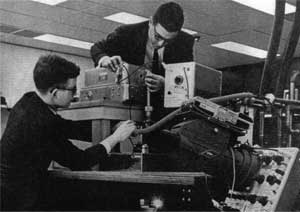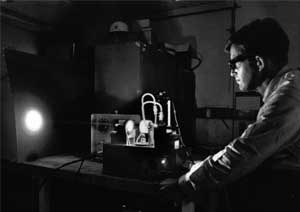Peter Sorokin
Could laser physics solve an astronomical puzzle?For the past five years, Peter Sorokin has pursued a new fascination with the stars. And it all goes back to his pioneering work with lasers. When astronomers graph how light from very bright stars is absorbed on its way to Earth, they see a prominent bump peaking at 2175 angstroms, a wavelength of ultra-violet light. Since the 1960s, astronomers have attributed this perplexing absorption to carbon molecules in space dust. But Sorokin thinks laser-like effects might be responsible. "I believe that new kinds of lasers exist spectacularly in bright stars," he says. According to Sorokin's theory, hydrogen molecules, alternately propelled directly away from and back toward the star, emit intense, coherent ultraviolet light at a few select wavelengths, just like a laser. This laser light propagates inwards; when it hits other hydrogen molecules in its path, it induces them to absorb ultraviolet light from the star at 2175 angstroms. Despite the skepticism of astronomers, Sorokin continues to scan data on stars for evidence for this laser effect. "Astronomers [tell me] to always remember Occam's razor, that the simplest explanation here is that there is lots of carbon-based dust," he says. "But that's not science, that's guessing." |
Before he invented the world's second and third lasers, pioneered the ability to build lasers in all colors of the rainbow, and became an IBM fellow, the company's highest technical honor, Peter Sorokin was a graduate student at Harvard University, struggling to finish his thesis.
"For a year I sat at a desk in the Gordon McKay Laboratory with a pad of paper," Sorokin recalled of his initial attempt to tackle a theoretical problem about nuclear magnetic resonance. When the year was up and he showed his advisor, future Nobel laureate Nicolaas Bloembergen, the results, "he looked at me and said, 'Well, Peter, I think you'd better do experiments'"(Hecht, 141).
So Sorokin dutifully began studying NMR signals from a certain class of chemical compounds. But the device he was given to measure the signals seemed to have a diabolical mind of its own.
"I couldn't get a good signal," he said. "I was floundering there for a year."
This marked a low point in Sorokin's confidence.
"I was certainly not very happy," he said. "I didn't think I could finish my thesis."
When his long hours at the lab refused to bear fruit, Sorokin began to wonder whether he was cut out to be a physicist. He'd always loved building radios and tinkering with electronics, and his favorite classes in college were physics and math. But four years of graduate school had gone by, and there was no end in sight.
"I had great doubts about what I was going to do," Sorokin said. "I might have dropped out."
Then a postdoctoral researcher named Al Redfield arrived in the lab, bringing a new device for measuring NMR. Sorokin immediately suspected the device might be perfectly suited to studying his compounds. He built his own version, turned it on, and got a beautiful signal the very first time.
"I got really excited and instantly realized that I had a thesis," he said (Hecht, 142). Within a year, Sorokin had his Ph.D., a published paper, and a research job under physicist Bill Smith at IBM. His greatest moment of self-doubt had been transformed into a life-long source of confidence.
"It gave me a shot in the arm," he said. "If Redfield hadn't been there I would have been discouraged and dropped out of graduate school."
Just months after he arrived at IBM intending to do more research on nuclear magnetic resonance, two physicists published a paper that changed physics, and Sorokin's career, forever.

Peter Sorokin (left) colleague Mirek Stevenson (right) with the world's second laser, in 1960. Photo courtesy of IBM."

Peter Sorokin with the flash lamp-pumped dye laser, in 1968. Photo courtesy of IBM
"I think we all felt that... this was the subject to focus on," Sorokin said. "We started thinking, 'How are we going to make a laser?' and the word 'laser' wasn't even there yet." Physicist Gordon Gould hadn't yet coined the term. "It just seemed like the thing to do. The sky was the limit."
Sorokin had a hunch that calcium fluoride crystals, doped with either uranium or samarium, might be lasers if they were shaped so that their surfaces would reflect light internally.
The team that had ordered the crystals were about to polish them when, in June of 1960, they heard that the race was over. Theodore Maiman at Hughes Research Labs in California had created laser light by exciting the atoms in a ruby crystal with a photographer's flash lamp.
"We were astounded at how they pumped it," Sorokin said. "So at that point, when we heard what Maiman had done, we ordered a flash lamp just like his."
Sorokin and Stevenson polished the uranium-doped crystal into a dowel and silvered each end for reflectivity then placed it in a holder where it could be both cryogenically cooled and irradiated by some of the light from the flash lamp. "It worked on the first shot," Sorokin remembers. "We had been beaten, but we had made the second laser." The samarium crystal soon became the third.
These discoveries marked the beginning of a long and prolific career exploring the new territory of laser science. In 1964, Sorokin's group at IBM invented the saturable dye Q-switch; they found that a solution of organic molecules inside a ruby laser cavity transformed intermittent pulses into a single, short, intense light pulse. In 1966, the group discovered dye lasers; by firing the ruby laser or even a flash lamp at different solutions of organic molecules, they could produce laser light of any color. Later that year, they observed a new effect that allowed them to create short pulses of tunable infrared light. In the seventies, Sorokin and colleagues pioneered ultraviolet lasers, developing a laser they could tune to any wavelength of ultraviolet light.
Sorokin is now retired with the prestigious title of IBM Fellow Emeritus, but that hasn't stopped him from doing science. These days he's working on a novel theory that uses laser physics to explain a chunk of the spectrum that's mysteriously missing from the light of many stars.
From a vantage point of fifty years, he now looks back on his rough graduate school days not with pain, but with pride."The fact that I almost quit, but then found something just following my own hunches, gave me a lot of confidence, and I've retained that confidence all through my career," he said. "That experience set my course in science" (Hecht, 142).
Works cited:
Hecht, Jeff. Laser Pioneers. San Diego: Academic press, 1985. Print.
Also of interest:
P. P. Sorokin, "Contributions of IBM to laser science---1960 to the present," IBM J. Res. Dev., vol. 23, pp. 476-489, (1979).











